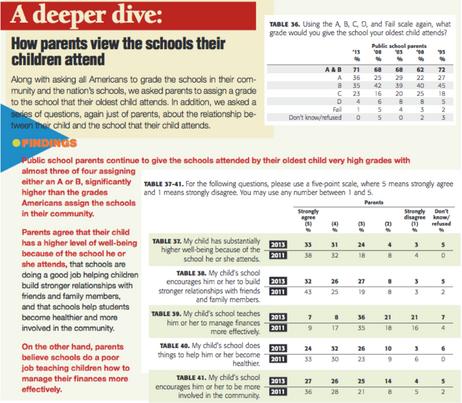A new PDK/Gallup Poll offers some interesting statistics on how parents view the current state of public schools. While standardized testing did make its way into the poll, more parents were worried about school funding than how to assess school and student performance. Most parents also thought their neighborhood school was doing a pretty good job, although they didn't rank public schools as well nationally. Read on to learn more about how parents see the condition of public education today.
About the Poll
The poll is a collaborative effort between Phi Delta Kappa and Gallup. It is conducted annually and is considered one of the best-known research instruments today. This year, researchers surveyed more than 1,000 Americans over the age of 18, asking questions from previous years and questions new to this year's survey. Because it is performed annually, researchers are able to track changing views of the education system and evaluate new ideas and processes in public education.
The Standardized Test Question
With No Child Left Behind and Common Core Standards still floating around Washington, the big question remains whether standardized testing is proving its worth in the education realm. According to this recent poll, parents don't find standardized testing very valuable for their children. Less than one-quarter of those polled thought tests had improved the quality of education in public schools. Three-quarters believed testing had made no difference or even hurt the education environment for students.
Standardized testing came in fifth this year on parents' concerns about schools today. While this issue fell behind concerns like funding and discipline, its new appearance on the list indicates the problem may be more significant. In addition to testing, parents added a lack of parental support and the ability to hire high-quality teachers to the list of their concerns.
Are Public Schools Passing or Failing?
Despite debates over standardized testing and other issues facing public schools today, the Christian Science Monitor reports that most parents responding to the poll have a generally favorable view of the public education system. This year, researchers received the highest grade for community schools ever recorded, indicating that most adults thought schools were performing fairly well.
Despite the high marks, the overall view of the public education system is lower than that of an individual's neighborhood school. The poll also found that while more than half of those surveyed would give their neighborhood school a grade of an "A" or "B", only 18 percent would provide the public education system in general a grade of "B" or better.
What do Schools Need to Succeed?
While much of the focus on school performance has been on properly evaluating teachers, parents seem to see the problem from a very different perspective, according to this poll. The Christian Science Monitor also reports that Americans see the lack of school funding as a bigger concern than standardized testing or teacher evaluations.
 from , via Wikipedia Commons
from , via Wikipedia Commons
Only one-quarter of those surveyed said more testing has improved the quality of public education. Over one-third said the biggest challenge facing public schools today is insufficient funding, and another seven percent said overcrowding is the biggest challenge. Other challenges that made this year's list included a lack of discipline within the school, a lack of parental involvement and support, and difficulties getting high-quality teachers.
What about the People Working in Public Schools?
 By Patsy Lynch (This image is from the FEMA Photo Library.) [Public domain], via Wikimedia Commons
By Patsy Lynch (This image is from the FEMA Photo Library.) [Public domain], via Wikimedia Commons
Teachers received favorable ratings in this year's survey. More than 70 percent of Americans trust public school teachers today, while 65 percent voiced confidence in public school principals. More than half (58 percent) oppose using student standardized test scores in teacher evaluations.
Many of those polled did not agree with publicizing student scores as a part of a teacher's performance rating. Nearly two-thirds oppose the release of student test scores for individual teachers in local newspapers. While 60 percent agreed that teacher performance should be published, more agreed that the performance of doctors and police officers should be published.
Will Common Core Standards Hurt or Help?
As 45 states prepare to incorporate the Common Core Standards into their curriculum, the new poll has found that few Americans understand what Common Core is all about. According to , 62 percent of Americans have never heard of the Common Core Standards. Of those familiar with them, nearly 40 percent believe the federal government requires all states to adopt them, and almost half think the standards extend to all academic areas.
The Obama Administration introduced Common Core Standards to emphasize 21st-century skills and provide consistent benchmarks for learning across all 50 states. The choice to adopt the standards, which encompass math and language arts benchmarks, is left up to individual states, although additional funding is provided to states that choose to use them. At this point, 45 states have agreed to adopt the standards to receive Race to the Top funding for their schools.
Are Schools Safe Enough for Students?
.jpg) by Keith Evans [], via Wikimedia Commons
by Keith Evans [], via Wikimedia Commons
Another important category in the PDK/Gallup poll this year involved school and student safety. In light of multiple school shootings in recent years, this category has taken on new significance for most Americans. Fortunately, the overwhelming majority of Americans were confident in student safety at school and believed children were even safer in school than playing in their own neighborhoods. Most parents polled also said they were satisfied of their children's safety in school.
Most respondents said they were more concerned about other students' actions than intruders entering a school. Forty-two percent of those polled believe schools should have screening methods and guards comparable to what is seen in courthouses and other government offices today. That same percentage does not think middle school teachers and administrators should be allowed to carry firearms. Two-thirds thought schools were better off focusing on improving mental health services for students than investing in additional security guards.
Learning the public perception of public schools is an essential step in the overall assessment process for education today. By following the results of this annual poll and others, education leaders and policymakers get a better idea of what needs to be done to ensure the success of public school students.
Questions? Contact us on Facebook @publicschoolreview















